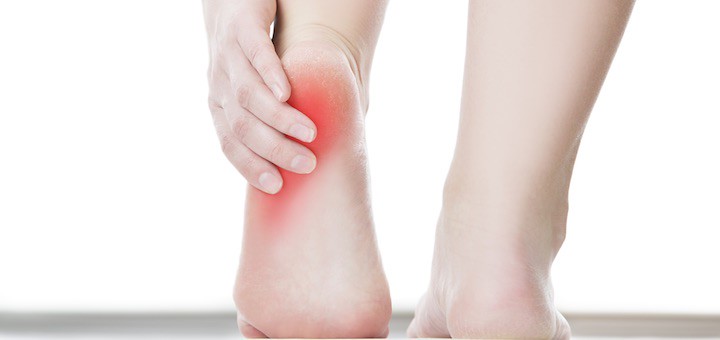Health
Plantar Fasciitis
Posted on October 3, 2019 by admin
Plantar Fasciitis is one of the most common causes of heel pain. When the plantar fascia, the flat band of tissue connecting your heel bone to your toes, is strained, it gets inflamed and swollen, and causes pain at the bottom of your foot or at your heel.
Most people with Plantar Fasciitis experience pain when they take their first step after sitting for a long time or getting out of bed. The stiffness and pain might reduce after a few steps. Some might also feel painful after climbing stairs and standing for a long time.
To treat Plantar Fasciitis, you have to give your foot a rest. Cut back from exercises and activities that make your foot hurt. You can also try to put ice on the affected area to ease the inflammation. Toe stretches, calf stretches and towels stretches are excellent stretching exercises to do to relief the pain. It’s always a good idea to get yourself a pair of orthotics to adjust how your shoes fit you.
Start your treatment soon! With the right treatment, you will experience much less pain in a few weeks, but it usually takes at least a few months to a year for the pain to go completely.
Text Neck
Posted on September 3, 2019 by admin
Excessive texting or mobile device use can cause stress injury to the neck, commonly known as the text neck. Symptoms associated might include pain in the neck, upper back and/or shoulder, forward head posture, rounded shoulders, headache, increased pain when neck flexion and reduced mobility.
A lot of extra pressure is put on your cervical spine when our head is bent. The unnatural posture can lead to stresses on the spine and surrounding supportive soft tissues.
Here are some tips to avoid text neck:
- Raise the phone to eye level to minimize bending of neck
- Take breaks from time to time while using your phone
- Stretching exercises during breaks to release tension in the neck and to ease muscle pain
If neck pain keeps returning or is accompanied by severe headache, one should seek medical attention for the right treatment.
Carpal Tunnel Syndrome
Posted on January 21, 2019 by admin
Carpal Tunnel Syndrome (CTS) is a chronic condition in the wrist area that can affect the arm and hands. An individual with CTS may experience numbness, tingling, and weakness in the affected hand. CTS is caused by the compression of the median nerve due to inflammation which runs through “carpal tunnel”. The carpal tunnel consists of the carpal bones (wrist bones) which create the base of the “tunnel” and the transverse carpal ligament that creates the roof.
Compression of the median nerve can be caused by many different aspects, most commonly due to the overuse of the wrist in an overextended position. Many individuals spend most of their time typing on the computer either due to work or gaming, the position the wrist is in when typing is in this overextended position and are more at risk for CTS. It is important to take notice of your hand position and make sure there aren’t long periods of time in the overextended position. If you are in this position due typing, ergonomic keyboards or rests for your wrist can help with the positioning.
Plantar Fasciitis
Posted on November 27, 2018 by admin
The plantar fascia helps support the arch of your foot. It is a thick band of tissue located at the bottom of the foot and connects your heel bone to your toes. Plantar fasciitis is when the plantar fascia becomes weak, swollen, and inflamed. Pain usually occurs with your first steps in the morning when you get out of bed or after sitting for a long time. Then the stiffness and pain decreases as you move more, however the pain may come back after long periods of standing.
People who walk, stand, or run for long periods of time are more likely to have plantar fasciitis. People who have high arches, flat feet, or tight Achilles tendons or calf muscles may experience plantar fasciitis. Overall, it is important to wear well fitted shoes and shoes that are not worn out.

Heartburn vs heart attack
Posted on October 22, 2018 by admin
Someone who has gastroesophageal reflux disease (acid reflux) can experience heartburn. A painful burning occurs behind the breastbone and you may feel pain that goes up toward your throat. When you lie down or bend over, the pain will get worse. You may have the feeling that food is entering back into your mouth. These symptoms usually occur after you finish a large or spicy meal.
Angina (when there is not enough blood flowing to your heart) can cause pain in your chest. Angina or a heart attack can cause tightness, squeezing, pressure, or dull pain in the middle of the chest. The pain can radiate to your neck, shoulders, or arms. Moreover, you may have trouble breathing, have an irregular heartbeat, or feel lightheaded, weak, or dizzy. Extreme stress or physical activity can lead to these symptoms.

High-Arched Foot
Posted on October 12, 2018 by admin
A high-arched foot can cause someone to have too much weight on the ball and heel of the foot when he or she is walking or standing. The heel of the foot is tilted inward and leads to an unstable foot. Therefore, a high-arched foot can increase the risk of getting an ankle sprain.
One may experience symptoms, such as pain when standing or walking and on the ball, side or heel of the foot one may find calluses. Also, hammertoes (bent toes) or claw toes (toes clenched like a fist) may be present. In some cases, one may drag his or her foot when he or she takes a step due to the weak muscles of the foot and ankle. This is known as foot drop. Therefore, custom orthotics can be used to help treat a high-arched foot because it gives us stability and acts as a cushion for the foot.

Flat feet
Posted on October 5, 2018 by admin
Flat feet (pes planus) is usually a painless condition in which the arches of your feet are flattened and when you are standing the entire soles of your feet touches the floor. Flat feet can change the alignment of your legs and can lead to knee and ankle problems. Infants and toddlers have flat feet since the arches of their feet have not yet developed. As they get older, the arches will develop. However, some people’s arches never develop and this would lead to flat feet. A foot or an ankle injury, aging, rheumatoid arthritis and obesity can all increase your risk of flat feet. One may experience pain in the heel or arch area of the foot and the pain may get worse with activity. Orthotics or supportive shoes can help reduce symptoms and make your feet feel more comfortable.

Cardiovascular Health
Posted on September 28, 2018 by admin
It is extremely important to maintain and improve your cardiovascular health. Doing a minimum of 150 minutes per week of moderate exercise or performing vigorous exercise for 75 minutes per week can improve your cardiovascular health. Being physically active five times a week and for at least 30 minutes a day can be a huge benefit for your heart. Jogging, walking, swimming or biking are examples of physical activities that are excellent for your heart.
Smoking, a diet low in fruits and vegetables, an unhealthy weight and getting less than 7-9 hours of sleep each night can affect your cardiovascular health and may lead to cardiovascular disease. It is important to visit your healthcare provider if you are at risk of cardiovascular disease. Therefore, a healthy lifestyle can lead to better health.

Chronic Inflammation
Posted on September 10, 2018 by admin
When we have a sore throat, a sun burn or sinusitis the process of acute inflammation occurs. White blood cells come in and then anti-inflammatory compounds will take over to start the healing process. Sometimes the activation of inflammatory molecules does not stop and this is known as chronic inflammation. It can be caused by environmental factors and it means that there is an issue with removing whatever caused the acute inflammation. Asthma and arthritis are examples of conditions that can result from chronic inflammation. Moreover, pain and chronic inflammation can occur if biomechanical issues, trauma or injury are left untreated.

There are a few ways to reduce chronic inflammation, such as staying away from foods that are high in saturated fats, trans fats and foods with a high glycemic index. Fruits and vegetables, nuts, beans and whole grains act as a natural anti-inflammatory and should be included in our diet. People who exercise regularly can heal faster from injuries and are less likely to have chronic inflammation. In addition, inflammation may be decreased with sufficient amount of sleep and by drinking water. Lastly, smoking should be avoided since it increases the level of inflammatory markers.
Heel Spurs
Posted on July 18, 2018 by admin
Heel spurs are also known as calcaneal spurs or osteophytes. Someone with this condition would find a calcium deposit forming a bony protrusion along the plantar fascia. Running and jumping, especially on hard surfaces can wear down the heel and lead to heel spurs. If the membrane that covers the heel bone is torn or if the heel is bruised, it can cause heel spurs. Older adults, obesity, plantar fasciitis, and improper footwear can increase the chance of developing heel spurs.

Heel spurs can lead to a sharp pain in the heel when he or she stands up, a dull ache in the heel, and heat radiating from the affected area. Tenderness, swelling, and inflammation can occur at the heel and a bone-like protrusion beneath the heel may also be seen. One can reduce pain and swelling by resting and applying ice to the affected area. Orthotics can also be worn to remove some of the pressure off the heel.
